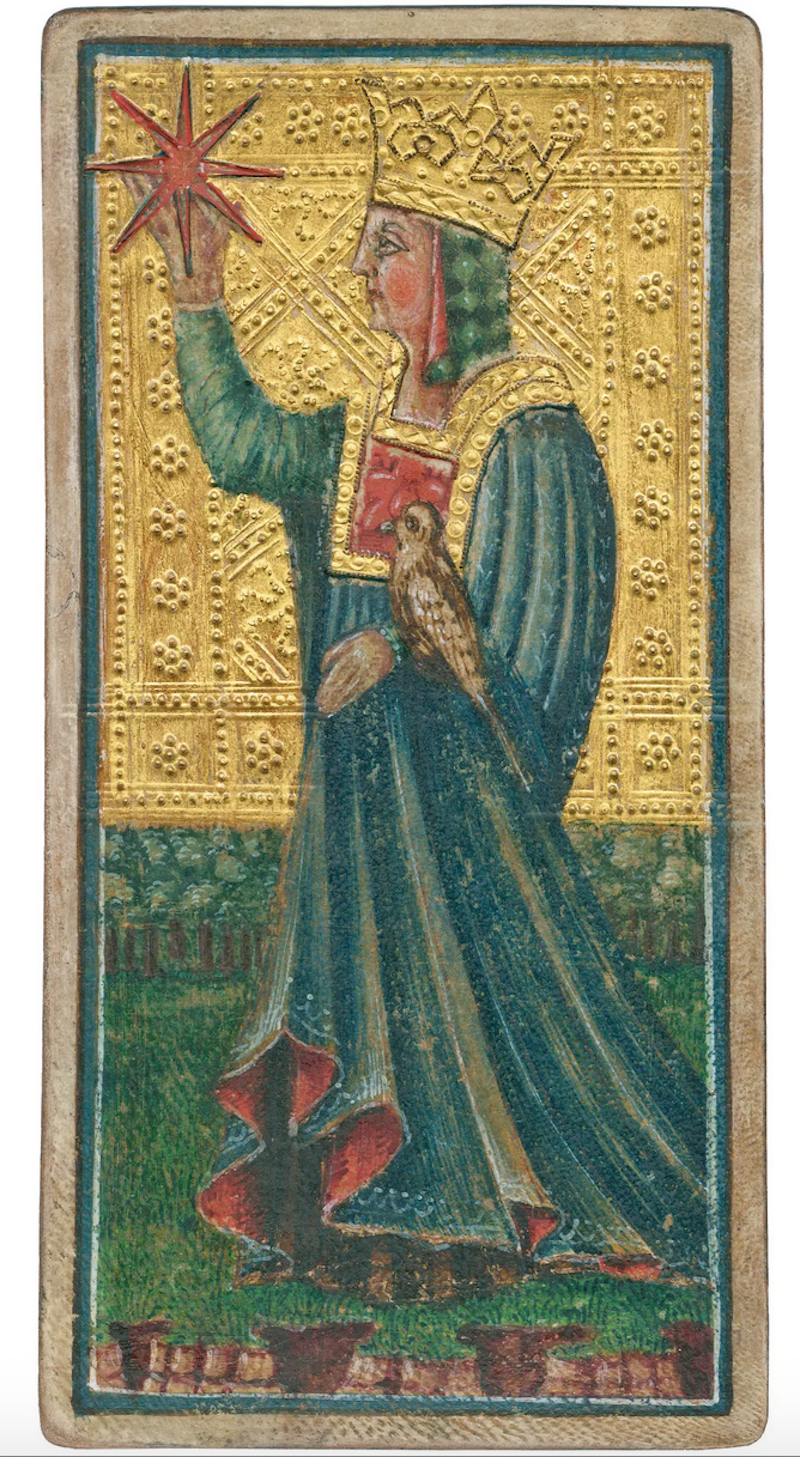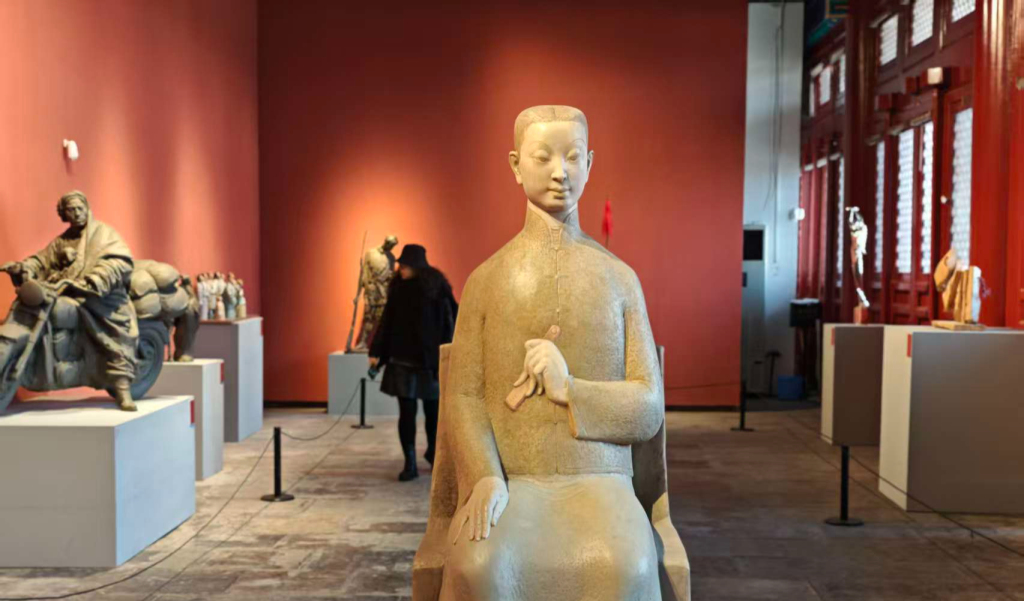
Today, tarot cards are everywhere. But where did they come from, and what is the relationship between different forms of cards? As a tool for exploration, a source of artistic inspiration, and a symbol of counterculture, tarot cards have always been about destiny, creativity, and identity shapers. The Paper Art learned that recently, the Warburg Institute of the University of London in the UK presented the exhibition "Tarot: Origins and Later Life", showing the long history of tarot cards, exploring their origins, and the evolution they have experienced in the hands of artists, mystics, and writers.
A street artist dances with his dog, a blind Cupid holds up a burning apple, and a hunchbacked Atlas carries the world on his back. Together, these images could mean new adventures that bring love and success, or they could mean that the user should be careful about hasty proposals, or that looking for love is a foolish thing. This is a tarot card drawn by Italian Baroque artist Giuseppe Maria Mitelli, and it resists a single interpretation.
Today, tarot cards are ubiquitous, inspiring a range of fashion, books and apps. But the cards' image has evolved over the centuries, changing with the times. A new exhibition, Tarot: Origins and Afterlife, on view at the Warburg Institute at the University of London, shows what the curators call a "pivotal moment" in tarot history, showing how a card game for the Italian elite during the Renaissance was transformed into a mysterious divination tool and eventually became a mainstream alternative belief.

The Star card from Bartolomeo Colleoni's 15th century Tarot deck
The exhibition dates back to 1909, when German art historian Aby Warburg, for whom the exhibition venue is named, began collecting tarot cards and books on the history of magic. His interest in tarot cards was part of a larger scholarly project to examine how myths and symbols from the ancient world have survived into the modern age. “He was particularly interested in endlessly reassembling photographs of artworks, including tarot cards, to suggest alternative visual and conceptual possibilities,” said co-curator Martina Mazzotta.
The exact origins of the tarot deck are unclear, but visitors can find some clues in the elaborate gold-leaf miniatures made by Italian artist Bonifacio Bembo in the mid-15th century. The miniatures are among the earliest known tarot decks. Curator Mazzotta said the cards’ designs show the growing influence of Renaissance ideals in Europe. In one card, known as the Star, a young woman points to a shining beacon, perhaps a metaphor for knowledge. Along with these precious objects are fragments of cards fished out of the waterworks of Milan’s Castello Sforzesco. Some of the fragments date back to 1499, and their careless discarding suggests that the tarot was then used as a card game.

Fragments of playing cards from the Castello Sforzesco in Milan
In the 16th century, the tarot left the Italian court and spread throughout Europe with the help of French soldiers returning from the Italian Wars. In Marseille, France, more efficient printing technology standardized the tarot game and gained corresponding popularity. By the 18th century, all decks contained 78 cards in four suits: Wands, Cups, Pentacles, and Swords, divided into 56 Minor Arcana cards and 22 Major Arcana cards. It was not until 1781, when the French priest and scholar Antoine Court de Gébelin discovered the tarot, that the tarot was associated with mysticism.

The Magician card in the Marseilles Tarot
De Gerberan, an assistant to Benjamin Franklin, Diderot, and other Enlightenment figures, saw a group of people playing Tarot cards in a Paris salon. He was immediately struck by the ancient Egyptian symbols hidden in the cards. Although this interpretation of the imagery had no factual basis, de Gerberan and his followers published articles promoting this view. One poster on display at the Warburg Institute was created by de Gerberan's follower, the mystic Eteira. The poster depicts the arrangement of the Tarot cards in the temple of Memphis in Egypt, with divination instructions.

Tarot cards from the Magic Circle collection

Tarot cards, once placed in the Fire Temple in Egypt, circa 1788
By the end of the 19th century, the tarot had developed along two parallel tracks, becoming both a popular fortune-telling tool and a key to occult knowledge. Perhaps the most influential tarot mystic group was the Hermetic Order of the Golden Dawn, a British secret society whose members included the poet WB Yeats. Another member, Arthur Edward Waite, created a tarot deck illustrated by Pamela Colman Smith.
Other mysterious decks on display in the exhibition offer even more eccentric visuals. One is a hand-painted deck by Austin Osman Spare that depicts the traditional meanings of the tarot in an almost psychedelic style. Spare’s words and images flow across the cards, showing intersections and relationships that are mesmerizing.

Two cards from the Austin Osman Spare Tarot deck, which depicts the traditional meanings of the Tarot in a symbolic, almost psychedelic style.
“I couldn’t believe what I had in my hands,” recalls Jonathan Allen, co-curator of the exhibition, who discovered the deck in the archives of the Magic Circle, a London society of theatrical magicians, more than a decade ago. Allen’s fascination with Spare’s deck inspired him to create the exhibition “Origins and Legacy.”
The tarot's magical era lasted until the 1960s, when it was adopted by the counterculture along with astrology and other alternative belief systems. But during this period, the tarot also became a means of artistic experimentation. In Mazzotta's opinion, "the tarot is very suitable for storytelling."

Tarot deck from the Institute for Psychical Studies
The narrative power of the tarot is on full display in Italo Calvino’s 1973 novel The Castle of Crossed Destinies. In this book, strangers in the castle and later in the tavern have lost the ability to speak and must tell their stories by arranging tarot cards on a table. Calvino spent years obsessively arranging and rearranging the cards to write these stories, and wrote at the end of the book: “I published this book to get rid of it.”

The Star card from Suzanne Trist's "Hexen 2.0" deck.
Contemporary artist Suzanne Treister's two decks take this paranoid style of tarot to an extreme. Her work explores the ideological and political history behind the rise of the Internet. In her "Hexen 2.0" deck, the Ace of Swords becomes a dark portal with a shining sun in the center surrounded by "information warfare," "hacktivists," and "unencrypted communications."
In the exhibition’s final room, visitors will find an interactive space with more decks that explore social and personal issues. Katie Anderson’s “Barrow Tarot” was created as a “conversational artwork” to help residents of the English town of Barrow agree on how to develop the run-down post-industrial area. The deck invites users to participate in what Anderson calls “fortune-telling for the future town.”

Katie Anderson's Barrow Tarot was designed to help residents of the English town of Barrow come to an agreement on how the area should be developed.
Visitors to the exhibition “Tarot: Origins and Afterlife” might still be wondering what the cards are for. Is Tarot a game? Is it a cheap form of therapy? Or an alternative to traditional religion? In these uncertain times, it may be useful to look back to the origins of Tarot as a tool for reflection and imagination.
Curator Allen believes that there are too few cultural spaces for truly speculative thinking and hopes that the exhibition will provide more space.
The exhibition will run until April 30th.
(This article is translated from The New York Times, and some content is compiled from the official website of the Warburg Institute)
